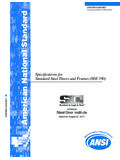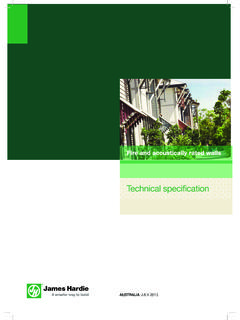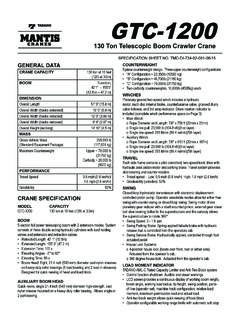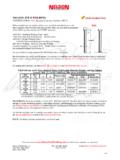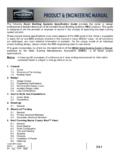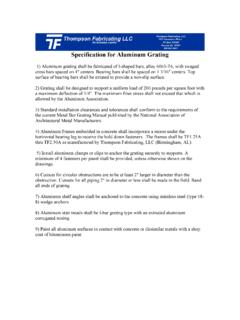Transcription of ANNEX SPECIFICATION FOR STRUCTURES TO BE …
1 ANNEX . SPECIFICATION FOR STRUCTURES TO BE BUILT IN DISASTER AREAS. CHAPTER I - GENERAL PRINCIPLES. SCOPE. - Requirements of this SPECIFICATION shall be applicable to newly constructed buildings as well as to existing buildings. - Provisions to be applied for the prevailing buildings of which the intended use and / or carrier system shall be changed, the performance shall be evaluated before or after the earthquake and buildings to be strengthened were given in Section - 7. - Requirements of this SPECIFICATION shall be applicable to reinforced concrete (cast-in-situ and pre - stressed or non - pre - stressed prefabricated) buildings, structural steel buildings and building-like STRUCTURES , and timber, masonry and adobe buildings. - Minimum conditions and rules to be implied to wooden buildings and such kind of buildings shall be determined by the Ministry of Public Works and Settlement until the provisions of relevant SPECIFICATION shall be put into effect and projects of them shall be arranged according to those basis.
2 - In addition to buildings and building-like STRUCTURES , non-building STRUCTURES permitted to be designed in accordance with the requirements of this SPECIFICATION are limited with those specified in of Chapter 2. In this context bridges, dams, harbor STRUCTURES , tunnels, pipelines, power transmission lines, nuclear power plants, natural gas storage facilities, underground STRUCTURES and other STRUCTURES designed with analysis and safety rules that are different than those for buildings are outside the scope of this SPECIFICATION . - Buildings equipped with special system and equipment between foundation and soil for the purpose of isolation of building structural system from the earthquake motion, and buildings incorporating other active and passive control systems are out of the scope of this SPECIFICATION .
3 - Rules to be applied to STRUCTURES which are outside the scope shall be specifically determined by the Ministries supervising the constructions and such STRUCTURES shall be designed to those rules until their own special specifications are prepared. The objective of this Part of the SPECIFICATION is to define the minimum requirements for the earthquake resistant design and construction of buildings and building-like of STRUCTURES or their parts subjected to earthquake ground motion. GENERAL PRINCIPLES. - The general principle of earthquake resistant design to this SPECIFICATION is to prevent structural and non-structural elements of buildings from any damage in low- intensity earthquakes; to limit the damage in structural and non-structural elements to repairable levels in medium-intensity earthquakes, and to prevent the overall or partial collapse of buildings in high-intensity earthquakes in order to avoid the loss of life.
4 Performance criteria based on the evaluation and reinforcement of the existing buildings is stated in Chapter 7. 1. - The design earthquake considered in this SPECIFICATION , corresponds to high- intensity earthquake defined in above. For buildings with Building Importance Factor of I=1 in accordance with Chapter 2, Table , the probability of exceedance of the design earthquake within a period of 50 years is 10 %. Earthquakes with different the probability of exceedance are defined in Chapter 7 in order to be considered in the evaluation and reinforcement of the existing buildings. - Seismic zones cited in this SPECIFICATION are the first, second, third and fourth seismic zones depicted in Seismic Zoning Map of Turkey prepared by the Ministry of Public Works and Settlement and issued by the decree of the Council of Ministers dated 18/04/1996 and numbered 96/8109.
5 - Buildings to be built in the seismic zones according to this SPECIFICATION shall be in accordance with Turkish Standards and General Technical SPECIFICATION of the Ministry of Public Works and Settlement in terms of materials and labor. 2. CHAPTER 2 - ANALYSIS REQUIREMENTS FOR EARTHQUAKE. RESISTANT BUILDINGS. NOTATION. A (T) = Spectral Acceleration Coefficient Ao = Effective Ground Acceleration Coefficient Ba = Design internal force component of a structural element in the direction of its principal axis a Bax = Internal force component of a structural element in the direction of its principal axis a due to earthquake in x direction Bay = Internal force component of a structural element in the direction of its principal axis a due to earthquake in y direction perpendicular to x direction Bb = Design internal force component of a structural element in the direction of its principal axis b Bbx = Internal force component of a structural element in the direction of its principal axis b due to earthquake in x direction Bby = Internal force component of a
6 Structural element in the direction of its principal axis b due to earthquake in y direction perpendicular to x direction BB = Any size calculated with the combination of mode contributions in the Mode-Superposition Method BD = Amplified value of BB. Di = Amplification factor to be applied in Equivalent Seismic Load Method to . %5 additional eccentricity at i'th storey of a torsionally irregular building dfi = Displacement calculated at i'th storey of building under fictitious loads Ffi di = Displacement calculated at i'th storey of building under design seismic loads Ffi = Fictitious load acting at i'th storey in the determination of fundamental natural vibration period Fi = Design seismic load acting at i'th storey in Equivalent Seismic Load Method fe = Equivalent seismic load acting at the mass centre of the mechanical and electrical equipment g = Acceleration of gravity ( m / s2).
7 Gi = Total dead load at i'th storey of building Hi = Height of i'th storey of building measured from the top foundation level (In buildings with rigid peripheral basement walls, height of i'th storey of building measured from the top of ground floor level). HN = Total height of building measured from the top foundation level (In buildings with rigid peripheral basement walls, total height of building measured from the top of the ground floor level). Hw = Total height of partition measured from under the foundation or from the ground floor hi = Height of i'th storey of building [m]. I = Building Importance Factor w = Length of partition or piece of strap partition on plan Mn = Modal mass of the n'th natural vibration mode Mxn = Effective participating mass of the n'th natural vibration mode of building in the x earthquake direction considered Myn = Effective participating mass of the n'th natural vibration mode of building in the y earthquake direction considered mi = i'th storey mass of building (mi = wi / g).
8 M i = In the case where floors are modeled as rigid diaphragms, mass moment of inertia around vertical axis passing through unshifted mass centre of i'th storey of building N = Total number of stories of building from the foundation level (In buildings with rigid peripheral basement walls, total number of stories from the ground floor level). 3. n = Live Load Participation Factor qi = Total live load at i'th storey of building R = Structural Behavior Factor Rdown, Rup = In case single storey frames with columns hinged at the top are used as top floor (roof top) in cast in situ reinforced concrete, prefabricated and structural steel buildings, R factors defined for lower stories and the top floor, respectively. RN = Structural Behavior Factor defined in Table for the case where entire seismic loads are carried by frames of nominal ductility level RYP = Structural Behavior Factor defined in Table for the case where entire seismic loads are carried by walls of high ductility level Ra(T) = Seismic Load Reduction Factor S(T) = Spectrum Coefficient Sae(T) = Elasticity spectrum ordinate [m /s2].
9 SaR(Tr) = Acceleration spectrum ordinate for the r'th natural vibration mode [m /s2]. T = Building natural vibration period [s]. T1 = First natural vibration period of building [s]. TA ,TB = Spectrum Characteristic Periods [s]. Tm , Tn = m'th and n'th natural vibration periods of building [s]. Vi = Storey shear at i'th storey of building in the earthquake direction considered Vt = In the Equivalent Seismic Load Method, total equivalent seismic load acting on the building (base shear) in the earthquake direction considered VtB = In the Mode-Superposition Method, total design seismic load acting on the building (base shear) obtained by modal combination in the earthquake direction considered W = Total weight of building calculated by considering Live Load Participation Factor we = Weight of mechanical or electrical equipment wi = Weight of i'th storey of building by considering Live Load Participation Factor Y = Sufficient number of natural vibration modes taken into account in the Mode- Superposition Method = Coefficient used for determining the gap size of a seismic joint S = Ratio of sum of shear forces developed at the bases of structural walls of high ductility level to total shear force developed at the bases for the entire building = Coefficient used to determine lower limits of response quantities calculated by Mode-Superposition Method i =
10 Storey drift of i'th storey of building ( i)ave = Average storey drift of i'th storey of building FN = Additional equivalent seismic load acting on the N'th storey (top) of building i = Effective storey drift of i'th storey of building ( i)mak = Maximum effective storey drift of i'th storey of building bi = Torsionally Irregularity Factor defined at i'th storey of building ci = Strength Irregularity Factor defined at i'th storey of building ki = Stiffness Irregularity Factor defined at i'th storey of building xin = In buildings with floors modeled as rigid diaphragms, horizontal component of n'th mode shape in the x direction at i'th storey of building yin = In buildings with floors modeled as rigid diaphragms, horizontal component of n'th mode shape in the y direction at i'th storey of building in = In buildings with floors modeled as rigid diaphragms.
